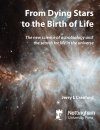![From Dying Stars to the Birth of Life From Dying Stars to the Birth of Life]()
Click to have a closer look
About this book
Contents
Customer reviews
Biography
Related titles
About this book
The rise of computers and rocket science in the last half of the 20th century allowed scientists to make two amazing discoveries that indicated life may be widespread throughout our universe.
In the 1970s, life scientists started finding small bacterial-like creatures living on our planet in extreme hostile environments that everyone believed should instantly kill any living things. Some of these life-forms lived in hot or boiling water that was extremely salty, acidic, or alkaline. A few made their homes inside icebergs, while others lived inside rocks located miles below ground, or even on the power rods of nuclear power plants.
These findings challenged science's long held belief that life is an extremely complicated and fragile process that demands equally complex and fragile environmental conditions. These strange creatures (which scientists call extremophiles or "lovers of extreme environments") appear to be the direct descendents of the earliest life-forms that evolved on earth almost four billion years ago when our world was extremely hot and believed to be totally incompatible with any kind of life. Scientists suddenly realized that life may be far more resilient, flexible, and adaptable than previously believed possible and might easily evolve on other worlds that have environmental conditions that are very different from those found on earth.
Then, in the late 1990s, astronomers began discovering that "homes" for such "hardy" alien life might also be very common in the universe. Powerful new ground-based and space telescopes have confirmed that our sun is only one of innumerable stars in our galaxy that has planets circling it. Many scientists now believe that definitive evidence of extraterrestrial life will be found well before the end of the 21st century.
Contents
Preface
- Computers, Rocket Science and the Birth of Astrobiology
- Our Vast and Hostile Life-Friendly Universe
- How Life Works on Planet Earth
- How Life and Earth Co-Evolved to Produce a Life Friendly Biosphere
- The Search for Other Worlds and Other Life-forms
- The Possibility of Visiting or Communicating with Extraterrestrial Civilizations
- Some Final Thoughts from the Author
Index
Customer Reviews
Biography
While the author has no formal training in astronomy or the space sciences, he has been a dedicated "amateur" in this area from childhood. After graduating from high school, the author chose to pursue a career as a brain scientist rather than upgrading his astronomy hobby to a fulltime occupation. Between 1964 and 1970, Professor Cranford earned a BA in Psychology from Wichita State University, a Ph.D in Experimental Psychology from Vanderbilt university, a Neuroscience Post-doctoral Fellowship from Duke University and, in 1984, a M.C.D in Clinical Audiology from Louisiana State University. Over the years working up from a Research Associate to an Associate Professor, to becoming a Professor in 1996, he has overseen various student theses and doctoral dissertations. He has also been involved in seven research grants exploring many topics associated with hearing science and deafness. He has written three textbooks and contributed over 60 journal articles. He has also been involved with many clinical studies in his area. Although now retired as a brain scientist, he continues to be a very active "amateur" astrobiologist (ergo the present book).


























